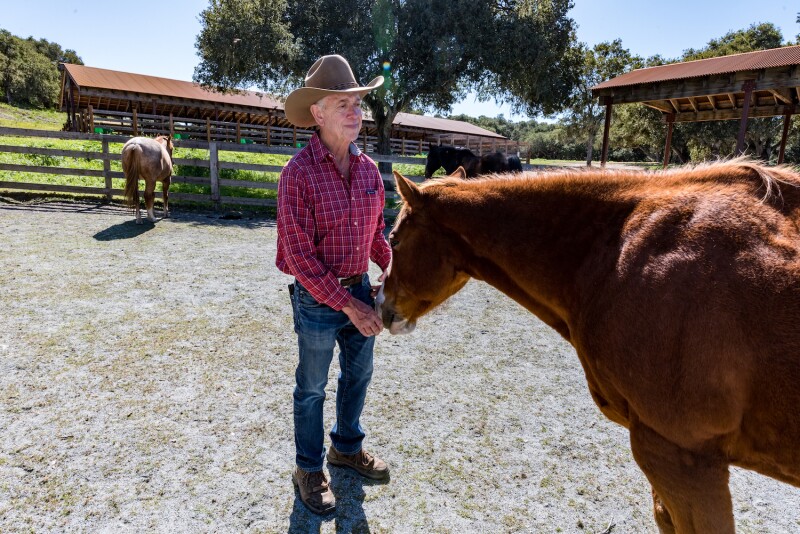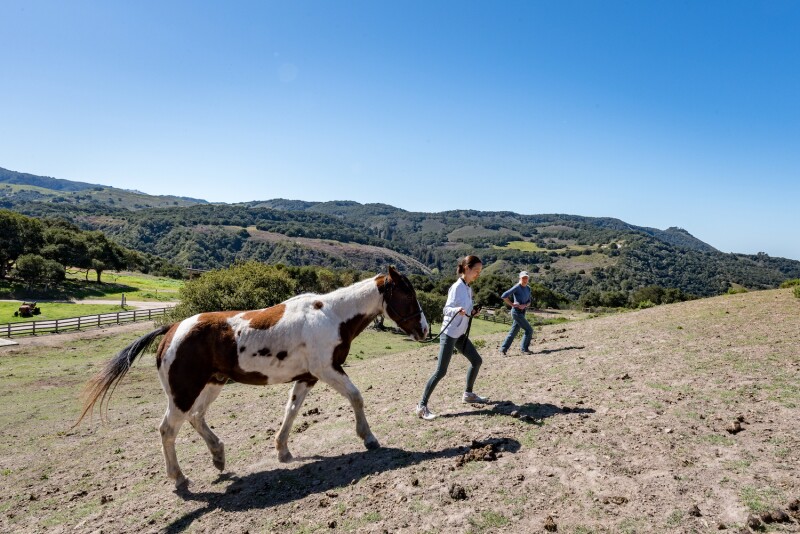On a breezy, sunny morning at Carmel Valley Ranch—a 500-acre oasis tucked into the foothills of the Santa Lucia Mountains—I arrived at the horse pen atop a grassy hill overlooking Carmel Valley. I was signed up for an “equine connection” experience, and when I heard the program was considered a wellness treatment, I pictured the slow rhythm of riding a horse lulling me into a meditative state. But within an hour of talking with the creators of the program—Robert Magnelli, PhD and psychologist, and his wife, Nancy Magnelli, a psychiatric nurse—I soon realized I would be working with the horses, not riding them.
I’ve always thought of spending time with horses as a feel-good experience. But I didn’t realize just how beneficial the presence of these majestic animals can be. Research shows that horses can “read human emotion and mirror it back,” explains Robert Magnelli. Nancy Magnelli adds, “It’s like seeing your emotional self on an IMAX theater.”
I learned that because horses are animals of prey, they’re constantly reading and reflecting the emotional intent of the other beings around them. For someone with a mental health condition, with stress or anxiety, for example, being with horses becomes an invitation to face their challenges.
“The real emotional struggles—anxiety, depression, post-traumatic stress disorder—people often hide them because they’re ashamed,” says Robert Magnelli. “But if I’m worried and try to hide it, the horses get anxious because that lack of authenticity is dangerous in the wild. If you acknowledge your emotions—the inside matches the outside—the horses relax because you are being authentic.”
Magnelli is speaking from experience—he’s spent the past 20 years studying the therapeutic benefits of spending time with horses. In their own study of 137 people prior to joining Carmel Valley Ranch, the Magnellis found working with horses benefited participants intrapersonally (their relationship with themselves improved), interpersonally (their relationship with others improved), and somatically (they physically felt better).

Robert Magnelli helps guests at Carmel Valley Ranch connect with horses.
Photo by Anna Haines
The Magnellis aren’t the only ones to shout the praises of interacting with horses. In 1952—at a time when therapeutic riding was beginning to develop in Europe, Canada, and the United States—equestrian Olympian Liz Hartel credited riding horses for helping her recover from polio. Therapeutic horse interactions even date back to ancient Greece, with Hippocrates mentioning riding in his writing.
But to ride on the back of a horse—according to Robert Magnelli—would be a missed opportunity: “There’s so much more that you don’t get to experience from being on their back,” he says. He also wants to make clear that the program he and his wife run at Carmel Valley Ranch, now in its second year, does not replace therapy. “When we say it’s therapeutic, it’s different than psychotherapy. It’s therapeutic in the sense that it makes us feel better and diminishes our emotional baggage,” says Magnelli.
The equine program at Carmel Valley Ranch isn’t limited to one kind of horse interaction. “Equestrian mindfulness” is an experience that teaches guests mindfulness techniques by prompting them to engage with all their senses before interacting with the horses while “equestrian-inspired watercolor” uses the experience with the horses to help guests explore emotions that are then expressed through painting. Magnelli says the program can also be beneficial for families as a way to make meaningful memories. When parents and caregivers “can be with their children outdoors, in nature with the horses, laughing and having fun, that builds a connection.”

The author participates in the equine connection program at Carmel Valley Ranch.
Courtesy of Carmel Valley Ranch
For someone like me who has anxiety, the equine program was especially stress-relieving. While I wouldn’t say I walked away from the experience with my anxiety forever healed, I did find that time slowed as soon as I stepped into the pen with the horse, named Flora. Petting the gentle giant while gazing into her glassy eye calmed my heartbeat. And it turns out I wasn’t just imagining it—there is a science behind horses’ calming effect.
“The research looking at electrocardiograms [ECGs] of people in the presence of horses shows there is a synchronizing of heart rhythms. That’s where the therapeutic aspect starts to happen, particularly with anxiety,” explains Magnelli.
The connection I experienced with Flora brought me into the present moment. As soon as my thoughts started to drift, I lost my synchronicity with Flora and she walked away.
Rather than coming to an equine session with a particular issue, as one might with therapy, guests first interact with the horses and work with whatever emotions come up. “A lot of what we do is trying to draw parallels with what’s going on between the guest and the horse and what’s going on in that person’s personal life,” explains Ciara West Equestrian founder Steven Ciarametaro. He runs the equine program at Canyon Ranch in Woodside, a retreat property nestled in the redwoods less than an hour’s drive south from San Francisco. I was so moved by my first equine experience, I signed up for another at Canyon Ranch two weeks later.
One of the exercises Ciarametaro uses to draw parallels between the guest’s experience in the pen and the person’s life back home is to practice the two types of energy that horses work with: invitational and motivational. According to Ciarametaro, the former is when you invite the horse to move with you, while the latter entails getting the horse to move away from you.
In my case, it was exerting motivational energy that I struggled with the most. Under Ciarametaro’s guidance, I stomped my feet and made forceful, grand gestures with my arms to try to impel the horse, Ulysses, to move. Instead, his heavy hoofs remained rooted to the dusty ground. The more effort I exerted with no response, the more my frustration and embarrassment swelled, and the more I doubted myself.
After what felt like hours (but in reality was probably five minutes), Ulysses finally moved away from me. My heart rate came down, and the beads of sweat above my furrowed brow dried.
“You were trying to think it, rather than feel it,” explains Ciarametaro. “We’re logical thinking animals. We don’t give enough attention to our feelings. Horses don’t respond to thoughts; they respond to feelings.”
He tells me many guests start crying when they give themselves permission to let their emotions flow freely. Working with Ulysses didn’t bring me to tears, but it did feel like, as Nancy Magnelli described to me two weeks prior, viewing my emotional self on an IMAX screen. While I walked away from my first experience with Flora feeling calm and grounded, this time, I was leaving the stable feeling more confident and self-assured. With such profound revelations from just two sessions, I can’t wait for another opportunity to get in the pen.
>> Next: How to Calm Your Travel Anxiety











